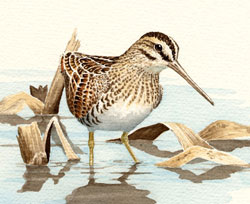Breeding Bird Atlases (BBA)
Find a Bird - BBA1
Breeding Bird Atlas 1 Species Accounts
Wilson's Snipe
Gallinago delicata
Egg Dates
not available
Number of Broods
one; may re-lay if first attempt fails.

Snipe were hunted heavily year-round in the 1800s but did not suffer extreme declines due to their occurring in loose flocks and their predilection for remote habitats. They can, however, be stressed seriously by droughts on the breeding grounds and freezing spells on their wintering grounds. Currently, the snipe is believed to be common to abundant throughout most of its range. In Massachusetts, the discontinuance of mowing wet meadows after 1910 resulted in a decrease in snipe habitat. Snipe historically bred in low numbers in eastern and central Massachusetts (and rarely in western Massachusetts), and they continue to breed locally in small numbers.
Snipe, like woodcocks, are early migrants. They begin departing the wintering grounds in early or mid-March, first as individuals or small groups, but flocking as the migration peaks in late March or April. Gregarious behavior diminishes en route, and the birds appear to arrive singly at the breeding grounds. Males arrive 10 or more days before the females. Spring migrants pass through Massachusetts between mid-March and mid-May, with resident birds usually at breeding sites by late March or early April.
The primary nesting grounds of the snipe are the peat lands of the boreal forest, composed of bogs, fens, and swamps with an understory of alder, Sweet Gale, and willow interspersed with clumps of larch, spruce, and fir. Snipe secondarily frequent matted areas of rotting vegetation along ponds, creeks, and wet meadows. In winter, they use coastal fresh and brackish marshlands, wet pastures, rice fields, and other sporadically flooded wetlands.
Male snipe begin displaying on arrival on the breeding grounds. The winnowing display, usually manifested at dusk or on moonlit nights (but sometimes during daylight), consists of a rapid high flight followed by a steep dive, during which air vibration around the center tail feathers produces a humming sound. During pair formation, males also fly over a female with arched wings and legs dangling. Displays or calls by intruding males may elicit sparring or other agonistic behavior. Both sexes produce a monotonous cutacuta...call or an excited yakking sequence during ground displays. Snipe also voice a hoarse scaipe call when flushed and use an abbreviated cutacuta call to summon lost chicks.
The nest is usually just above the water level and may be lined thoroughly with grass and sedges. Clutch size is normally four, but three eggs are not uncommon. Yearlings nesting in late summer appear to lay smaller clutches. Peak hatching in Newfoundland is in June. The young leave the nest immediately but are fed and brooded by the parents for about 10 days. Both sexes play a role in tending the young.
Little specific information about the nesting habits of snipe in Massachusetts is available. Birds are occasionally observed giving the “winnowing display” from April to June at areas of suitable breeding habitat. “Possible” breeders were recorded during the Atlas period in Bolton and Spencer. In 1978, a territorial pair called and displayed regularly at a small, damp sedge meadow on the East Bridgewater-Whitman line. Although the birds remained into June, breeding could not be confirmed (Petersen). Also in 1978, a territorial pair was discovered in the marshes along the Quaboag River in Brookfield. The birds were present by the end of April and remained into June. They were observed giving the distraction display on one occasion in early June (Meservey). After the Atlas period, a small, downy youngster was seen in Bolton on July 4 (McMenemy).
When the chicks are about six weeks old, they aggregate with others of the same age class while the adults are molting. By late summer, large aggregations, predominantly of immatures, are found on the choice feeding grounds. The onset of migration usually begins in late August with the peak occurring in mid-October. Snipe pass through Massachusetts until late November. Many probably make overwater flights directly from the eastern provinces of Canada to the West Indies. Snipe from eastern North America winter along the Atlantic coastal plain, in the West Indies, and in coastal regions of Colombia and Venezuela. Small groups are occasionally noted at coastal areas of Massachusetts in winter.
Map Legend and Data Summary
Atlas 1 data collected from 1975-1979


Note: rare and local in bogs and freshwater marshes; most frequent in western regions
James E. Cardoza



